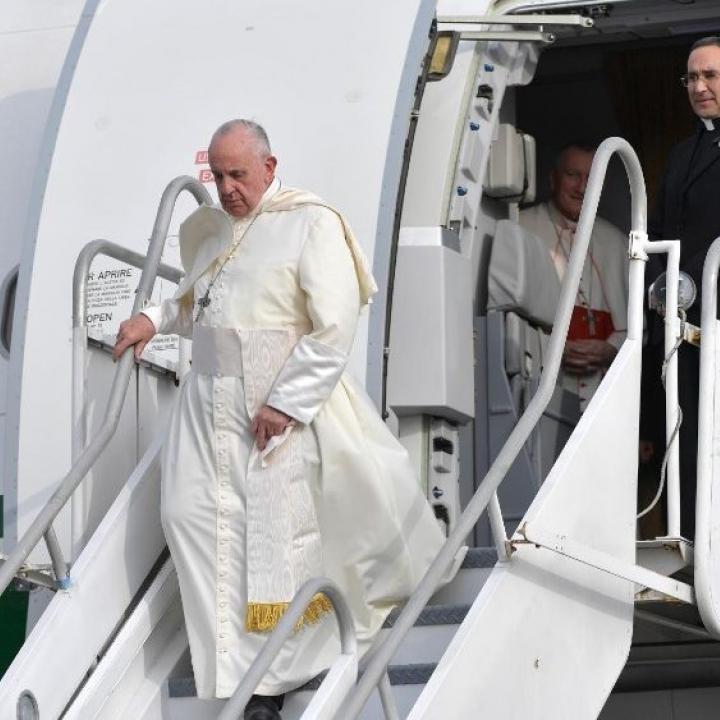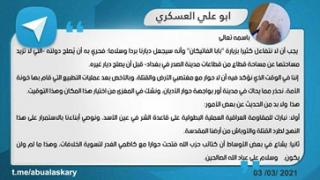
- Policy Analysis
- Fikra Forum
The Pope, Iraq, and the Iranian-Backed Iraqi Militias

The pope's visit in Iraq highlights Iranian-back militias' failure to successfully depict themselves as saviors of Iraqi Christians.
The pope’s visit to Iraq was a truly historic occasion for the people of Iraq and a major event within the realm of Christian-Islamic relations. Iranian-backed militia groups in Iraq used this event to push claims they are the only forces protecting Iraq’s Christians. Yet, this messaging campaign has exposed inherent weaknesses in Iran’s campaign to win over Iraqis and, to an even greater extent, Middle Eastern Christians.
Tone Deaf Messaging
Since late 2013, Iran and its proxies have rehashed narratives that their forces are protecting Christians and Christian holy sites from the advance of Sunni jihadists throughout the region. This narrative has often been mixed with a subtext that depicted a Shia-Christian minority alliance. Nevertheless, this type of messaging was highly selective, if not blatantly utilitarian. Those messages eventually came off as haggard, and they contradicted reality in many Christian towns and villages that were freed from ISIS’s yoke, particularly those towns now under the management of Iranian-backed Shia militias.
Prior to the pope’s arrival in Iraq, Iran’s proxies offered scant coverage of the visit. The lack of coverage could be viewed as an extension of how the visit was ignored and downplayed in Iranian media. From an ideological perspective, the pope’s meeting with Grand Ayatollah Sistani undercut Iranian Supreme Leader Ali Khamenei’s relevance as a spiritual and political leader among Shia Muslims and Iran’s Iraqi Shia proxy groups.
Still, the trip was too important to completely ignore. Initially during Pope Francis’s visit, many of the core network of Iranian-backed Shia militias, such as Asa’ib Ahl al-Haq (AAH, the PMF’s 41st, 42nd, and 43rd Brigades) and Kata’ib Hezballah (KH, the PMF’s 45th, 46th, and 47th Brigades), a U.S.-designated terrorist group, posted and circulated images featuring the pope with the tagline, “Does the pope Know?” (hal ya3lm al-Baba?).
“This is the hand that [allowed for] the return of the church bells,” read the tagline on one photo of slain IRGC-QF commander Qassem Suleimani’s hand and distinctive aqeeq stone ring, charred and severed in the U.S. strike. Another photo included the statement, “America killed [IRGC-QF and PMF commander Abu Mahdi] al-Muhandis” with “Churches of Peace” written underneath. AAH social media platforms uploaded another image containing Abu Mahdi al-Muhandis surrounded by Christian clergy members with the English translation, “The popular mobilization sacrificed for the survival of the church as it sacrificed for the survival of the mosque.”
Along with the pictures’ subtext that Christians were indebted to Iran’s proxies, this messaging also initially sought to cast doubt on the true purpose of the pope’s visit. In a statement on March 3, Abu Ali al-Askari, a spokesman for KH, discouraged excitement for the pope’s visit. He went on to warn that the pope’s interfaith prayer and unity meeting in the southern Iraqi city of Nasiryah was akin to the normalization of ties between Gulf Arab states and Israel.
Abu Ali al-Askari’s statement on the pope’s visit
However, these highly dismissive or pushy narratives were subsequently altered. The Iranian proxies’ media amplifiers uploaded more neutral material between March 3-6. Tura and Sabereen News, both linked to AAH and KH, shared photos of the pope’s meeting with Grand Ayatollah Sistani and the pope’s visit to Iraqi churches. Moreover, AAH leader Qa’is al-Khazali released a short and reserved statement that Iraqis welcomed the pope due to Islamic ethics and customary Arab hospitality. Even Lebanese Hezbollah released an announcement stating it supported the visit and Grand Ayatollah Sistani. The group reframed the pope’s visit as a necessary step towards addressing issues over which Hezbollah and other Iranian proxies constantly claim leadership: the fight against Israel, “Wahhabi terrorism,” and what the group claimed were “multiple American occupations.”
Hezbollah’s Statement on the pope’s visit
By March 7, a day before the pope left Iraq, the tone had returned to dismissiveness and passive aggressive critiques. Harakat Hizballah al-Nujaba, another core Iraqi Shia proxy for Iran, issued an op-ed that argued that there was a difference between a true spiritual leader “who works for God” and a politicized pope who “works with those who...besiege Iran, suffocate Lebanon, humiliate Syria and Iraq, and degrade and destroy Nigeria, and oppress Bahrain.”
Iran’s Deflated Christian Proxy
Simultaneously however, Iran’s Christian proxy in Iraq worked to present the pope’s visit in a different light. Rian Salem al-Sadiq, more popularly known as Rian al-Kaldani, is the leader of Harakat Babilioun, whose Kata’ib Babilioun is the PMF’s 50th Brigade.
From 2015 on, Iranian-backed PMF groups have heralded Kaldani as an example of cross-sectarianism and proof that Iran could be a protector for minority groups, particularly Christians. In January, Kaldani even appeared on the pro-Hezbollah channel al-Mayadeen in January to extol the values of the IRGC-QF and its support for his group, claiming, “Suleimani did not tell [my group] to do anything. He only asked one thing: [That we] look after Christians. To protect the Christians and Muslims.” Kaldani additionally presented his group as having liberated Christian villages from ISIS. Posing with fighters wearing armed camouflage and holding Chaldean flags and crucifixes, Kaldani has paraded Chaldean ethno-religious symbolism [CC1] as a sign that Iraqi Christendom was “down but not defeated.” Even Kaldani’s nom de guerre means, “The Chaldean.” On the other hand, there are no illusions over Kaldani’s open alignment with Iraq’s Iranian-backed factions, making him appear to be little more than an opportunistic pawn who hardly serves a representative for Christians attempting to rebuild their shattered communities.
Even so, the pope’s visit should have presented a natural opportunity for an Iranian-backed Iraqi Christian group to gain further leverage, but this is not how things played out. Initially, Iran’s al-Alam News circulated a claim that Pope Francis presented Kaldani with a rosary. Numerous Iranian-backed sites, particularly those belonging to Iraqi Shia militia groups, subsequently circulated a photo of the rosary. Kaldani himself appeared in another circulated photo, featuring a lineup of politicians and other figures greeting the pope, though Kaldani’s back was turned to the camera.
Kaldani is an extremely controversial figure among Iraq’s Christians, particularly Chaldeans, and has repeatedly offended local church officials. In the summer of 2019, Chaldean Patriarch Louis Sako singled out Kata’ib Babilioun, saying, “forming a Christian armed militia contradicts the Christian spirituality that calls for love, tolerance, forgiveness and peace.” Kaldani responded by criticizing the popular Chaldean cardinal and arguing the church had become politicized.
In 2019, Kaldani was sanctioned by the U.S. Department of Treasury for corruption, including the expropriation of large tracts of land in the Ninewa Plains, Iraq’s Christian heartland. Kaldani has further isolated himself as a result of his opposition of greater autonomy in the area, a cause that many of Iraq’s Assyrians, Chaldeans, and Syriac Christians support.
The majority of the fighters for Kaldani’s “Christian” group are also Shia Arabs and Shabak Shia. In what were once Christian majority towns like Bartella, Shabak Shia and their Iranian-backed militia groups (primarily linked to the major Iranian-backed proxy, the Badr Organization),including Kata’ib Babilioun, dominate these zones. They have also come into conflict with local Christian civilians, political groups, and armed groups.
Two of the five seats in Iraq’s parliament allotted for Christians were won by Harakat Babilioun in 2018. However, these seats were not won through Christian support, but through organized assistance from other Iranian proxies that mobilized sections of Iraq’s Shia population to vote for them.
Combining these factors, Kaldani’s position in the Christian community and his continued complete support for the IRGC-QF’s goals and messaging in Iraq has left him as a little more than an Iranian puppet. The lackluster propaganda presented by his Iranian-backed allies further demonstrates how his group’s and Iran’s efforts have lost touch with Iraq’s Christians.
Iran and Its Proxies’ True Face Presents an Opportunity
For most Iraqis, the pope’s visit was viewed as a time for national prominence and togetherness. This time, Iraq was not a focal point due to violent activities or international powerplays in the country. Iran’s ideological, theological, and political issues with the visit led to over-projection and a distinct messaging failure. Iran’s blatant hypocrisy, tone, and overreach in their approach to Iraq’s Christians does more to isolate them in Iraq than maintain or win over new support, and it provides a window of opportunity for the United States.
First, the United States can provide real support to Iraq’s remaining minorities as they continue to recover in the wake of the ISIS genocide against Christians, Shia, Shabaks, Yezidis, and other groups. The United States should continue its efforts in assisting the reconstruction of these communities. Work with NGOs through USAID should also be continued. Acknowledgement of present realities should also influence these operations; the United States can exert special effort to reach communities that have been particularly threatened by Iranian-backed elements.
In contrast with the failed Iranian messaging, the United States was relatively silent regarding the pope’s visit. This was a smart move that helped demonstrate that Washington would not take the Iranian approach of overbearing micromanagement regarding Iraq’s internal affairs. However, highlighting Iranian hypocrisy on the activities of their militia proxies, their highly negative approach to the internationally and domestically popular visit by the pope, and Iran’s Iraqi proxies’ unwillingness to treat the event as a positive for Iraq should be regular talking points for U.S. policymakers.
The United States should also take note[PS2] [CC3] of the pope’s positions and what they mean in an international context vis-à-vis Iran. The pope’s visit to Ayatollah Sistani, a figure with a moderate approach that contrasts with Iran’s radical theocracy, undermined Iran’s quest to be viewed as the leader of the world’s Shia. Pope Francis, despite pressure from Iranian-backed militant groups, did not single out PMF organizations for praise or reaffirm their messages in any way. Despite criticisms regarding the presence of PMF leaders, the pope’s cold, albeit forgiving, shoulder sent the correct signals. The pope not only snubbed Iranian militia leaders cum politicos,[CC4] but also selectively chose which Christian sites to visit. He made sure to tour Qaraqosh, a town liberated by U.S.-backed Iraqi forces, and not Christian towns controlled by Iranian-backed militias. Harakat Babilioun’s need to remain relevant resulted in a propagandistic flourish in which the group told the press that the pope had been “informed” about the role of the PMF and how the PMF “preferred” to have “Christians liberate their churches.” The group claimed it would share the message they passed to the pope for the public “later.”
Washington’s position is not like Tehran’s, and the United States should be firm on this. Unlike Iran, the United States does not seek to dominate minority communities, use its members as cannon fodder, or subvert their representation in Iraq’s government. Iranian-backed Iraqi PMF organizations have often stood in the way of redevelopment and the preservation of minority communities. These realities cannot and should not be swept under the rug.





